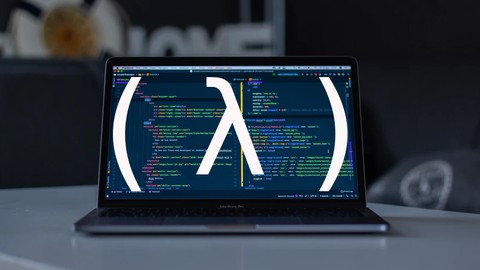
Common Lisp programming: from novice to effective developer
Common Lisp programming: from novice to effective developer, available at $54.99, has an average rating of 4.33, with 54 lectures, 4 quizzes, based on 177 reviews, and has 1384 subscribers.
You will learn about Understand the Common Lisp way Master the image-based, interactive Common Lisp workflow Learn functional constructs, error handling, CLOS, and more Understand Lisp macros, symbolic computation and compile-time computing Use Common Lisp for day-to-day scripting Develop and deploy real-world applications This course is ideal for individuals who are Anyone programmer wanting to learn the power of Common Lisp, quickly. or Students of computer science who want to discover why Lisp still has un-matched alien technology inside. or Young(ish) profesional developers who feel they deserve a more fun, comfy, compiled and fast programming language. or Python or JavaScript programmers frustrated by the unstability of their ecosystem. or Your friend or colleague. It is particularly useful for Anyone programmer wanting to learn the power of Common Lisp, quickly. or Students of computer science who want to discover why Lisp still has un-matched alien technology inside. or Young(ish) profesional developers who feel they deserve a more fun, comfy, compiled and fast programming language. or Python or JavaScript programmers frustrated by the unstability of their ecosystem. or Your friend or colleague.
Enroll now: Common Lisp programming: from novice to effective developer
Summary
Title: Common Lisp programming: from novice to effective developer
Price: $54.99
Average Rating: 4.33
Number of Lectures: 54
Number of Quizzes: 4
Number of Published Lectures: 54
Number of Published Quizzes: 3
Number of Curriculum Items: 58
Number of Published Curriculum Objects: 57
Number of Practice Tests: 1
Original Price: $39.99
Quality Status: approved
Status: Live
What You Will Learn
- Understand the Common Lisp way
- Master the image-based, interactive Common Lisp workflow
- Learn functional constructs, error handling, CLOS, and more
- Understand Lisp macros, symbolic computation and compile-time computing
- Use Common Lisp for day-to-day scripting
- Develop and deploy real-world applications
Who Should Attend
- Anyone programmer wanting to learn the power of Common Lisp, quickly.
- Students of computer science who want to discover why Lisp still has un-matched alien technology inside.
- Young(ish) profesional developers who feel they deserve a more fun, comfy, compiled and fast programming language.
- Python or JavaScript programmers frustrated by the unstability of their ecosystem.
- Your friend or colleague.
Target Audiences
- Anyone programmer wanting to learn the power of Common Lisp, quickly.
- Students of computer science who want to discover why Lisp still has un-matched alien technology inside.
- Young(ish) profesional developers who feel they deserve a more fun, comfy, compiled and fast programming language.
- Python or JavaScript programmers frustrated by the unstability of their ecosystem.
- Your friend or colleague.
Common Lisp is an awesome language. It has pioneered a LOT of concepts in computer science, and while old it is still used in the industry by Big Corps (all quantum computing ones, Google) as well as one-person companies (me!). I’ll help you learn it efficiently.
UPDATE June, 2024: the first 8 videos about CLOS are done and are being published, one by one, editing the subtitles on the go.
There aresubtitles.
The sound quality dramatically improvedsince the beginning in 2021. The new videos (iteration, projects, conditions, macros…) have perfect audio. I re-recorded the sound of 3 old videos (last update: January, 2023). The sound of some videos have glitches (some remaining in the “functions” chapter). I’ll re-record more step by step. Thanks!
I publishcomplementary videoson Youtube (vindarel channel).
If you subscribe now, you’ll get the next chapters at the same price.
Lisp the language is different than the Algol/C-like family of languages, and the Lisp development environments still offer unmatched capabilities: interactive, image-based development experience, while getting type warnings and errors at compile time in a fraction of a second, speed in the same group of C, Rust and Java (while sweating less to get to the result), while ensuring stability through decades, etc, etc, etc.
However, you are about to enter a big new world. There are rough edges, the information is sometimes spread apart and hard to discover, despite my continuous work on collaborative resources.
So, I gathered my knowledge and experience of more than six years of continuous reading, tweaking, writing, asking and answering questions, discovering libraries, trial and error, releasing open-source libraries, starter kits and demo projects, contributing to ambitious projects and running commercial services… into this series of videos.
We will learn the language, the tools, the most important pieces of the ecosystem (a dozen libraries viewed so far), in order to be able to develop a Common Lisp software from the ground up. We will see some theory on what a Lisp language is but, be warned, theory isn’t our goal, we’ll quickly dive into the Common Lisp way. I will develop with Emacs and Slime (you can use Atom/Pulsar, Vim, VSCode, Sublime, Jetbrains/Intellij, LispWorks, Lem, CLOG or a simple text editor along with a command line prompt as we see in the first chapter), we will learn the syntax, we will create new projects some scratch, we will see everything about functions and macros, all the iteration constructs, error and condition handling, the CLOS object system (new in 2024) and we will build self-contained binaries.
The Common Lisp Cookbook (which I mainly wrote) is a good companion to this video series.
I am genuinely happy to share all that with you in this new video format and I wish you a fun journey.
PS:pro tip: if you find a video too slow or if you think you know the content, watch it at speed x1.25 or x1.5. However I recommend to not skip content, as I give tips here and there and inside a section we build on the previous video’s content.
Course Curriculum
Chapter 1: Getting started
Lecture 1: Install SBCL
Lecture 2: Run Lisp code from your terminal, write code with a simple text editor
Lecture 3: Portacle: a portable, multiplatform, ready-to-use Common Lisp IDE
Chapter 2: Lisp basics
Lecture 1: Lisp syntax and evaluation model
Lecture 2: Variables
Lecture 3: Conditionals
Chapter 3: Iteration
Lecture 1: Iterating over lists and vectors
Lecture 2: Iterating over a hash-table keys and values
Lecture 3: Iterating a fixed or infinite number of times
Lecture 4: Loop: high level overview and gotchas
Chapter 4: All about functions
Lecture 1: How to create named functions, how to handle all types of arguments
Lecture 2: Referencing functions, redefining functions locally, accessing documentation
Lecture 3: Multiple Return Values
Lecture 4: Higher Order Functions
Lecture 5: Closures
Lecture 6: setf functions
Lecture 7: Generic Functions (quick intro, sneak peak to CLOS)
Chapter 5: Working with projects
Lecture 1: How to work with an existing project
Lecture 2: How to create a new project
Lecture 3: What are systems and packages anyways?
Chapter 6: CLOS: the Common Lisp Object System
Lecture 1: CLOS crash course – part 1
Lecture 2: CLOS crash course – part 2
Lecture 3: Pretty printing
Lecture 4: DEFCLASS review
Lecture 5: Custom constructors
Lecture 6: INITIALIZE-INSTANCE: control if and how any objects are created
Lecture 7: Multiple inheritance
Lecture 8: DEFGENERIC vs DEFMETHOD: when to use which, which is better?
Chapter 7: Error and condition handling
Lecture 1: How to create an error, a warning and a simple-condition
Lecture 2: How to handle ("catch") all sorts of errors and conditions
Lecture 3: How to define our own errors
Lecture 4: IGNORE-ERRORS
Lecture 5: UNWIND-PROTECT: the "finally" in try/catch/finally
Lecture 6: HANDLER-BIND doesn't unwind the stack.
Chapter 8: MACROS
Lecture 1: Quick intro
Lecture 2: C macros VS Lisp macros
Lecture 3: QUOTE (simple quote)
Lecture 4: BACKQUOTE and COMMA: the second most important macros mechanism
Lecture 5: How to spot you are using a macro
Lecture 6: Functions VS macros
Lecture 7: COMMA SPLICE ,@ the third most important macro mechanism
Lecture 8: &body and other macro parameters. Our second macro model.
Lecture 9: Putting this together: with-echo macro. Macroexpand in use.
Lecture 10: GENSYM -the simple fix to the most dangerous macros gotcha
Lecture 11: CALL-WITH pattern: simplifying macros
Lecture 12: Compile time computing
Lecture 13: Lists VS AST
Lecture 14: Two example macros for compile-time computing
Lecture 15: SYMBOL-MACRO
Lecture 16: Read-time evaluation with #.
Lecture 17: EDITOR TOOL: macrostep
Chapter 9: Additional and optional content
Lecture 1: NEW – Scripting with batteries included
Lecture 2: (external content) Debugging Common Lisp: don't restart from zero after a bug
Lecture 3: (external content) HTTP requests, JSON, building a binary, CLI args
Instructors
-
Vincent Dardel
Full-stack developer
Rating Distribution
- 1 stars: 7 votes
- 2 stars: 10 votes
- 3 stars: 30 votes
- 4 stars: 55 votes
- 5 stars: 75 votes
Frequently Asked Questions
How long do I have access to the course materials?
You can view and review the lecture materials indefinitely, like an on-demand channel.
Can I take my courses with me wherever I go?
Definitely! If you have an internet connection, courses on Udemy are available on any device at any time. If you don’t have an internet connection, some instructors also let their students download course lectures. That’s up to the instructor though, so make sure you get on their good side!
You may also like
- Best Ui Ux Design Courses to Learn in December 2024
- Best Aws Certification Courses to Learn in December 2024
- Best Data Science Courses to Learn in December 2024
- Best Digital Marketing Courses to Learn in December 2024
- Best Web Development Courses to Learn in December 2024
- Best Javascript Courses to Learn in December 2024
- Best Python Programming Courses to Learn in December 2024
- Top 10 Interior Design Courses to Learn in December 2024
- Top 10 Writing Courses Courses to Learn in December 2024
- Top 10 Storytelling Courses to Learn in December 2024
- Top 10 Creativity Workshops Courses to Learn in December 2024
- Top 10 Resilience Training Courses to Learn in December 2024
- Top 10 Emotional Intelligence Courses to Learn in December 2024
- Top 10 Time Management Courses to Learn in December 2024
- Top 10 Remote Work Strategies Courses to Learn in December 2024
- Top 10 Freelancing Courses to Learn in December 2024
- Top 10 E-commerce Strategies Courses to Learn in December 2024
- Top 10 Personal Branding Courses to Learn in December 2024
- Top 10 Stock Market Trading Courses to Learn in December 2024
- Top 10 Real Estate Investing Courses to Learn in December 2024





















